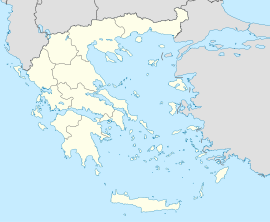- Dadia
-
Dadia
ΔαδιάLocation Coordinates 41°8′N 26°13′E / 41.133°N 26.217°ECoordinates: 41°8′N 26°13′E / 41.133°N 26.217°E Government Country: Greece Region: East Macedonia and Thrace Regional unit: Evros Municipality: Soufli Municipal unit: Soufli Population statistics (as of 2001) Village - Population: 823 Other Time zone: EET/EEST (UTC+2/3) Auto: EB Dadia (Greek: Δαδιά) is a village in the northwestern part of the Evros Prefecture in Greece located south-southwest of Orestiada, southwest of Soufli north of Feres. Dadia is linked with the road connecting to the GR-51/E85 (Alexandroupoli - Soufli - Orestiada - Ormeni) to the east. Dadia is in the municipality of Soufli. Its 2001 population was 800 for the village and 823 for the municipal district.
The name originates from a resinous pine wood which in the past was used for lighting.
Contents
Subdivision
- Kotronia (Κοτρωνιά) [2001 population: 23]
Nearest places
- Kornofolia, northeast
- Lykofi, southeast
Population
Year Village population Municipal district population 1981 826 - 1991 737 - 2001 800 823 Geography
Dadia is between the Thracian Plain and the Gkibrena mountains to the west. Farmlands are within the village along with the eastern portion.
The nearby forest and its ecosystem
The forests of Dadia is well known and it one of the most important biological in Europe. The area of the forests includes characteristic specimen in the inland ecosystem in which had formed inside from centuries with mild natural and human coexistence. The rich forest
It has preserved 36 of the 38 species of birds in Europe and includes many along with the Aquila heliaca and Aquila pomarina. It is one of the only area in Europe in which had many different birds of prey of Europe and is the only one with three of Europe's four species of eagle.
History
The first inhabitants of Dadia arrived to find refuge. The residents left for that large city in which it built Kornofolia which is located northerly near Sougli, the settlement of Lefkimmi and the employees of Daida were next to the forests.
Dadia was in the Ottoman Empire until the Balkan Wars of 1913 and was known as Chamkoy or (Τσιάμκιοϊ, Çamköy) meaning Pefkochori, the pine village, instead of Greece, it joined Bulgaria since it was invaded by them and administered until the Greco-Turkish War which finally ceded to Greece mainly without any battles. During the Catastrophe, refugees arrived from the east and forms a majority of the population today. After World War II and the Greek Civil War, many of its buildings were rebuilt. Some of its residents moved to other parts of Greece and the world. Its population lost by about two thirds of the 1981 population that made the village lost the most population in Thrace. Much of the population left for larger towns and cities as well as its suburbs around Greece and other parts of the world.
Arzos has a nearby tomb dating back to the 4th century BC.
Electricity and automobiles arrived in the 1960s, it was linked with pavement in the late-20th century, television arrived in the 1980s. Internet and computers arrived in the late-1990s.
See also
External links
- The Dadia forest at the Greek WWF site (Greek)
- Dadia on GTP Travel Pages
References
Municipal unit of Orfeas Municipal unit of Soufli Municipal unit of Tychero Categories:- Populated places in Evros (peripheral unit)
Wikimedia Foundation. 2010.

